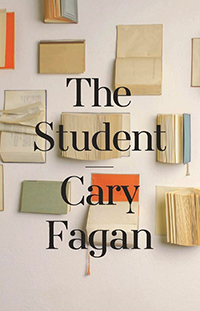Reviews
Fiction Review by Liam Andrews
Cary Fagan, The Student (Calgary: Freehand, 2019). Paperbound, 184 pp., $21.95.
 Young-adulthood is a period of vast opportunity and change. However, along with its myriad possibilities comes a creeping set of anxieties: “How do we know we’re making the right decisions?” “What should we be investing our time and devotion in?” And, worse still, “If we do manage to decide on a dream, what can we do if society and circumstances prevent us from following it?”
Young-adulthood is a period of vast opportunity and change. However, along with its myriad possibilities comes a creeping set of anxieties: “How do we know we’re making the right decisions?” “What should we be investing our time and devotion in?” And, worse still, “If we do manage to decide on a dream, what can we do if society and circumstances prevent us from following it?”
Cary Fagan’s novel is set in the eye of one such emotional whirlwind, following Miriam “Minnie” Moscovitch, a soon-to-be English graduate from Toronto’s University College circa 1957. Miriam is the living embodiment of the academic spirit, having spent her undergraduate years voraciously reading in order to gain a broad view of arts and culture. She and her bohemian friends discuss everything from poetry and literature to stage plays and French cinema, and this panoramic scope of knowledge is reflected in Fagan’s winding and intelligent prose. Every line at this stage of the story is dripping with the wide-eyed restlessness of university life, where one's thirst for knowledge and a scattershot collection of open-level courses combine to form the first confident buddings of worldly wisdom.
At the height of Miriam’s excitement about the next stage in her life, her pursuit of professorship is abruptly snuffed out by an esteemed but extremely prejudiced faculty member. After this devastating disappointment, The Student turns its focus towards the frustrations that Miriam feels regarding the people in her life and the expectations set on her by society. Her boyfriend, Isidore, is loyal and grounded, but his conservative mindset—along with plans of settling down, starting a family, and inheriting his father’s dry-cleaning business—suffocates Miriam. Their strained relationship culminates in a palpably awkward picnic where Miriam realizes that their futures are inexorably incompatible. The dialogue here is subtle and painful, capturing the sinking feeling of two young lovers who have grown apart both physically and idealistically.
The novel touches upon Miriam’s confrontation with societal expectation again through the character of Faiga, first mentioned early in the story as Miriam’s closest childhood friend. Despite their ostensibly close bond, Faiga doesn’t actually appear until near the novel’s halfway point, when we learn that Miriam has been avoiding opportunities to catch up with her and meet her newborn child. When the two briefly reunite, the dialogue again communicates Miriam’s disinterest and discomfort in the face of such traditional and safe life choices. Though The Student takes place all over a lovingly rendered mid-century vision of Toronto, with many references to local streets and establishments, it’s in the simple setting of the Moscovitch household that the story gains a memorable and earthy intimacy. In quiet evenings around the television, summer getaways to a cottage, and small moments of conflict and love between family members, a sense of warm safety pervades the story. Still, Miriam finds it stultifying and this makes her desire to leave the nest all the more relatable.
Eventually, Miriam finds escape from the stagnation of middle-class Toronto in fellow student Charlie, an idiosyncratic and politically active beatnik. Offering a new avenue to channel her intelligence, youthful energy, and sexuality, he introduces her to jazz and free love, and brings her attention to the ongoing racial tensions in Little Rock, Arkansas. Where Miriam’s mind was once completely occupied with school and art, she now finds a potential purpose in devotion to activism, the dream of becoming a professor replaced by that of participating in protest hundreds of miles away. Yet this new devotion threatens to further strain Miriam’s bonds with the people closest to her, and soon tests her commitment to following her heart.
In the final third of the novel, the timeframe suddenly shifts half a century ahead to 2005, where readers find Miriam as an accomplished and proud grandmother. Same-sex marriage has just been legalized in Canada, and one of her sons is being married to his partner that evening. Through her efforts to make sure the wedding goes smoothly amongst familial troubles, we learn a lot about the older Miriam and how life’s twists and turns have tempered the fiery personality from 1957. Her comfort in the matriarchal role in the new Moscovitch family is extremely gratifying, as her children and grandchildren echo the intimacy that was present in the family of her youth. Along the way, changes to the character of Toronto are subtly noted, with its diverse and progressive culture in stark contrast to the traditionalism of the past.
Unfortunately, the events of 2005 feel disconnected from the conflicts of Miriam’s past, becoming more like an extended epilogue than a cohesive resolution. Significant events are related secondhand through memories and words of her children, leaving readers to fill in the blanks of the metamorphoses that led her to improve upon her faults. While we can’t help but be happy for who Miriam has become, it’s hard not to wish we could have been there to witness the events unfold.
The Student is ultimately a powerfully grounded exploration of the confusions we feel in youth. Through Miriam’s struggles to find her own unique purpose while other expectations are continually forced upon her, Fagan crafts a message about self-determination and our ability to be a positive influence on the world around us.
—Liam Andrews









